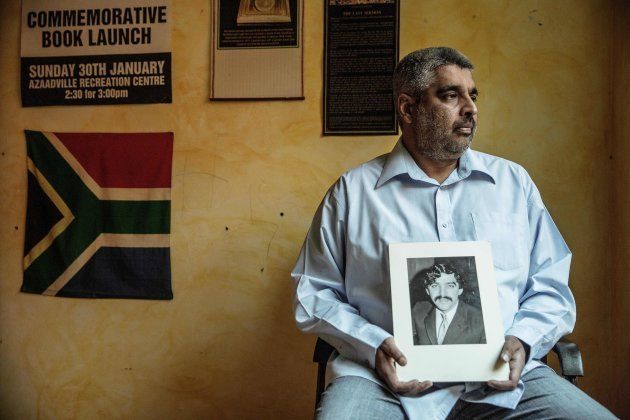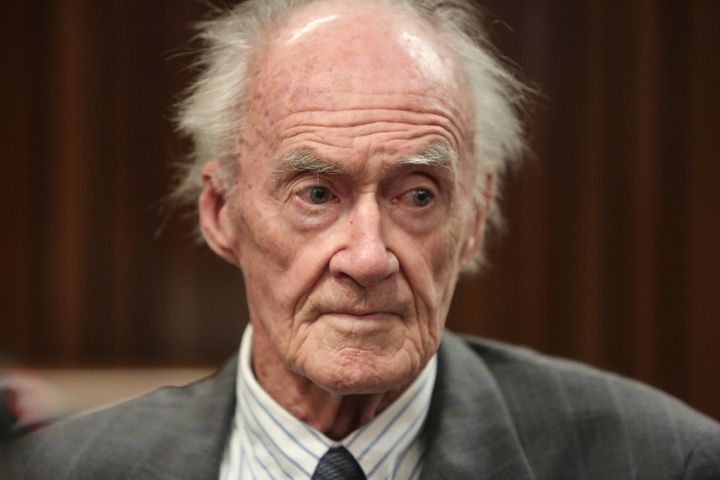Ahmed Timol's image is frozen in time, 46 years after his death. As one of the last photographs taken of him has flashed across the news, he is still the dark-haired dapper young activist and communist underground operative. But Timol died a violent death, flying down 10 floors of the John Vorster police station on the southern edge of Johannesburg and landing on the pavement below. Dead just a week before his 30th birthday.
A police inquest at the time found that he had committed suicide but decades later, a crack team of activists, lawyers, investigators, a resilient nephew and friends worked to reopen the inquest in an effort to overturn it. Over 18 court days, the country watched avidly as the history books were opened up and a painful past of torture, detention and cover-ups oozed back into the national consciousness.

In a documentary on Timol's life, lawyer George Bizos, who acted for the activist's family at the first apartheid inquest, said he sought to show that "Indians can't fly" after the police alleged he had jumped from the 10th-floor window of the police station where eight other detainees met their end.
A painful past of torture, detention and cover-ups oozed back into the national consciousness.
Today (Thursday) is the final day of arguments in the reopened inquest ahead of an inquest finding, which will be made later.
The woman who wouldn't let history sleep
"It represents a breakthrough in dealing with unfinished business," says Yasmin Sooka, the executive director of the Foundation for Human Rights and also a former commissioner at the Truth and Reconciliation Commission (TRC). Since the TRC shut up shop, Sooka has doggedly pursued justice in 300 cases where perpetrators of various human rights abuse did not tell the truth or apply for amnesty. The TRC was based on the principle of amnesty in return for truth; if there was no truth, then justice should prevail.
"This model of reconciliation has been sold to the rest of the world," says Sooka, but in practice it failed because there was no appetite in the then new democratic state to pursue cases like Timol's.
The unfinished business of apartheid explains why amnesty trumps justice in cases of corruption.
The police did not investigate and the National Prosecuting Authority's efforts were at best tepid. If you don't reckon with history and secure justice, says Sooka, the institutions of a democratic state can suffer. As an example, she points to the recent findings of the police watchdog Independent Police Investigative Directorate which reveal that torture by police is still widespread and that the investigation and prosecution thereof is low.
And she says the failure to complete the unfinished business of apartheid explains why amnesty trumps justice in cases of corruption. Recently, the Daily Maverick reported that there was serious consideration being made to giving President Zuma amnesty when he steps down, although the legality of this is doubtful.
"After the TRC, people kept coming to us. I was angry," says Sooka to explain why she could not walk away from history and its body count as many have done. Families of people who had died did not feel that the TRC had resulted in truth or justice about their loved ones.
So Sooka and her network of good did not let the painful history of deaths in detention enter the annals. The international war crimes investigator Frank Dutton, with others, spent months combing through the Timol files and the history of the investigation, to poke the holes in it to persuade the state to reopen the inquest.
A loving nephew
All uncles want a nephew like Imtiaz Cajee. Timol's nephew has made it his life's work to pursue justice for his uncle. Cajee has written a book on his life and he found the people who day after day brought Timol's story back to life as they gave evidence about him at the inquest.
Forensic pathologists laid out the anatomical detail, in six parts, of how a body falls from a tall, tall building and how it lands.
One of those people is Salim Essop, who spent hours with HuffPost SA this week regaling the team with stories of his and Timol's life. The two were friends and comrades whose political and personal world's intersected. Essop was the last person, who was not a security branch cop, who saw Timol alive. In the painstaking work of putting together the inquest, Cajee and the legal team pieced together a compelling case, says Essop.
Political luminaries like former ministers Ronnie Kasrils, Essop Pahad and activist Stephanie Kemp, who were all members of the SA Communist Party (SACP), were character and comradely witnesses to Timol's life. They disputed the arcane notion that he died as part of a communist creed to take your own life if placed in danger.

The team contracted independent forensic pathologists who laid out the anatomical detail, in six parts, of how a body falls from a tall, tall building and how it lands. This evidence will be used to argue that Timol could not have committed suicide.
An architect walked the inquest court through the design of John Vorster square -- a hulking building at Johannesburg central city's gritty southern edge where the security branch occupied the ninth and tenth floors. You didn't want to end up there where so many met their end and the dastardly ways of the security branch cops were infamous amongst activists.
The banality of evil
In turn, the state called three witnesses, all previous security police officers. "It was so interesting to listen to those lies," says Essop, who was detained with Timol and later jailed on Robben Island. "'I can't remember. I didn't see,'" says an incredulous Essop about the narrative of the cops. "It is so similar to war criminals around the world." Essop is writing a book on political cover-ups and he has studied the lives of the police officers who gave testimony.
They were likely ordinary middle-class men who went to church and spent time with friends and families, surmises Essop, but who lived double lives as killing machines in pursuance of a political goal. Their lives remind him of the term the "banality of evil" coined by the political scientist Hannah Arendt in reference to Nazis.
When one of the cops, Seth Sons, told the inquest that he did not remember torture at John Vorster Square, the ANC deputy secretary-general Jessie Duarte was enraged.
"He forgot that he made me kneel next to my brother Achmat (Dangor, the author) as his goons searched our house for six hours. He refused my grandmother entrance to the toilet and she wet herself. He slapped my mother when she wanted to hug her sister."
Their lives remind him of the term the "banality of evil" coined by the political scientist Hannah Arendt in reference to Nazis.
Then, Duarte wrote publicly but directly to Sons: "You knew what took place in that space. You stood with folded arms as many of us were choked. You cannot say you did not torture; you were the torture master."
Sooka says many, many former detainees wrote to them giving further evidence as the inquest ricocheted the painful past into the present. There is more work to do, not less as this inquest winds up, she says. Seven years after Timol's death detainee Matthews Mabelane was thrown from the tenth floor. His dad who is 95 years old attended every day of the Timol inquest.
Sooka says they will seek justice for him too. Then, there are cases to be opened in relation to the deaths of Griffiths and Victoria Mxenge, the activist Durban lawyers murdered by apartheid's death squads and also of the guerilla Nokuthula Simelane who disappeared on a mission back to South Africa. You get the sense Sooka will not stop until the 300 cases left when the TRC shut are pried open for the scrutiny of democracy's daylight.
The end and the beginning
Essop holds the last civilian account of Timol's final days. In October 1971, they were arrested after being stopped at a roadblock coming from Fordsburg to Newclare in Johannesburg. Communist pamphlets in the boot of the yellow Anglia they were driving alerted the cops to the two men being pay dirt.
At the time, the apartheid state parlayed its repression into a fight against communism in an attempt to escape international scrutiny: this was the narrative of the "rooi gevaar" or the red danger. Communism's colour is blood red.
You cannot say you did not torture; you were the torture master."
Essop was tortured until near break point. Three days into detention, he saw, through the cell he was being held in, a hooded and injured figure being walked through the corridor by two cops who were holding him up.
Essop believes that this was Timol. Two days later, Timol was dead. How will justice look for Timol so many years after his death and why does it matter? "It's a matter of principle. If we get a reversal of the suicide theory, it will vindicate his life," says Essop.